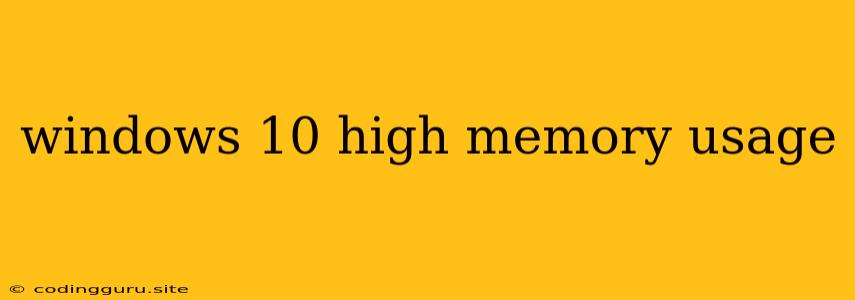Windows 10 High Memory Usage: A Common Problem and How to Fix It
Have you noticed your Windows 10 computer feeling sluggish and slow? Perhaps applications are taking longer to load, or you're experiencing frequent freezes. These are common symptoms of high memory usage, a frustrating issue that can impact your overall computing experience.
Why is my Windows 10 using so much memory?
There are numerous reasons why Windows 10 might be using a high amount of RAM. Here are some common culprits:
- Running too many applications simultaneously: Having multiple programs open at once, especially resource-intensive applications like video editing software, can easily eat up your available RAM.
- Background processes: Windows itself runs numerous background processes that consume memory, including system updates, antivirus scans, and cloud syncing.
- Malware and viruses: Malicious software can stealthily use up your RAM and slow down your system.
- Outdated drivers: Outdated drivers for your hardware can lead to memory leaks or inefficient usage.
- Hardware problems: In some cases, faulty RAM modules or other hardware issues can cause high memory usage.
How to troubleshoot and resolve high memory usage in Windows 10
Now, let's dive into practical steps to tackle high memory usage on Windows 10:
1. Task Manager: Your First Line of Defense
- Open Task Manager: Press Ctrl+Shift+Esc or right-click the taskbar and select "Task Manager."
- Identify Resource Hogs: Navigate to the "Performance" tab and observe memory usage. Check the "Processes" tab to identify which applications or services are consuming the most RAM.
- End Unnecessary Tasks: Right-click on any processes you don't need running and select "End Task." This will force the process to close.
2. System Configuration:
- Disable Startup Programs: Many programs automatically start when you boot your computer. To manage these programs, go to "System Configuration" by typing "msconfig" into the search bar. Select the "Startup" tab and disable any programs you don't need to start automatically.
- Disable Unnecessary Services: Navigate to the "Services" tab in System Configuration. You can disable any services you don't need running, but be cautious as some services are crucial for your system's stability.
3. Clean Up Your System:
- Disk Cleanup: Use the built-in "Disk Cleanup" tool to delete temporary files, system files, and other unnecessary data. This frees up disk space and can indirectly improve memory usage.
- Uninstall Unused Programs: Review your installed programs and uninstall any you no longer need. This reduces the number of processes competing for RAM.
4. Update Your Drivers:
- Driver Updates: Out-of-date drivers can cause inefficiencies and memory leaks. Visit your hardware manufacturer's website to download the latest drivers for your devices.
5. Check for Malware:
- Virus Scan: Run a full system scan with your antivirus software. If you don't have an antivirus installed, consider downloading a reputable free antivirus program.
6. Optimize Your System:
- Windows Performance Settings: Go to "Control Panel > System and Security > Performance Information and Tools." Click "Adjust visual effects" to tweak your system's performance settings.
- Virtual Memory: Virtual memory is a temporary swap file that your system uses when RAM is insufficient. You can adjust the size of the virtual memory file to potentially improve performance. Go to "System Properties > Advanced System Settings > Advanced > Performance."
- System Restore: If you suspect your system is experiencing problems due to recent changes, try performing a System Restore to revert to a previous point in time.
7. Consider Upgrading Your RAM:
- Increase Your Memory: If you have a large amount of programs running and still face high memory usage, consider adding more RAM to your computer. This provides your system with additional resources to handle demanding tasks.
Examples:
Let's say you're experiencing slowdowns while working on a video editing project in Windows 10. You open Task Manager and see that your video editing software is consuming 80% of your RAM. You might consider:
- Closing other unnecessary programs: Close any browser tabs, email clients, or other applications that you're not actively using.
- Adjusting video editing software settings: Lower the resolution or frame rate of your project to reduce the demand on your system.
- Temporarily disabling antivirus scans: If you're in the middle of a critical task, temporarily disabling antivirus scans might free up some RAM.
Conclusion:
High memory usage in Windows 10 can be a frustrating issue, but by understanding its causes and implementing the tips and solutions outlined above, you can often significantly improve your system's performance. Remember to prioritize your system's overall health by maintaining a clean and efficient environment, updating drivers, and keeping your software up to date.
